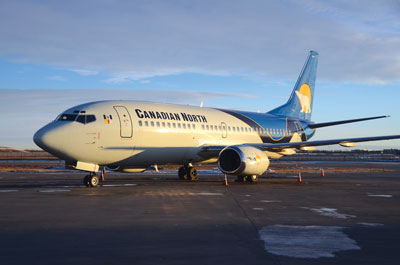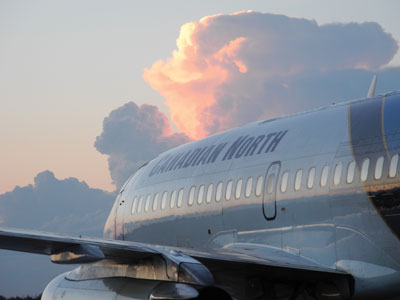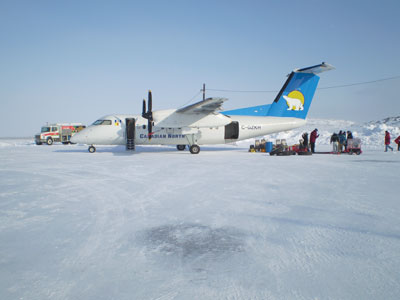
Features
Operations
Navigating the pitfalls
Aviation in northern Canada is tethered to global demand for minerals. The resource boom that drove growth in 2011 slowed last year, but is showing signs of heating up in the first quarter of 2013.
March 6, 2013 By David Carr
Aviation in northern Canada is tethered to global demand for minerals. The resource boom that drove growth in 2011 slowed last year, but is showing signs of heating up in the first quarter of 2013. “There are a couple of big gold projects coming into play,” says Steve Hankirk, president of Canadian North, one of the “big four” northern airlines, predominantly serving the Northwest Territories and Nunavut. “There is also a large iron ore find on Baffin Island. These are all exciting projects and mean steady growth for the airline.”
 |
|
| Canadian North is one of the far north's most iconic carriers. PHOTO: James Redeker
|
Air transport across Canada’s Northwest, Nunavut and Yukon territories is a study in contrast. Approximately 112,000 people – one third of one per cent of Canada’s population – are spread out in 65 communities dotted along four million kilometres of unforgiving geography, accounting for 40 per cent of Canada’s land mass. With few year-round roads or marine links, the airplane is the only access point for most communities, essential for delivering fresh produce, milk and meat, and the reason residents north of 60 fly twice as much as those living south of the line.
Even so, northern operators must navigate through a mine field of gravel runways that are too short, and deal with inadequate weather aids that can keep airplanes grounded and spotty fuel distribution that often leaves airport fuel tanks dry and airlines sacrificing payload to bring their own gas. It’s a small wonder that Tracy Medve, Hankirk’s predecessor at Canadian North, and Joe Sparling, president and founder of Air North, Yukon’s airline, once made a presentation at a major Toronto airline finance conference entitled: You Fly Where?. (For more on Air North, see “Yukon’s aerial economic catalyst,” page 38).
“Our carriers run the gamut from the large scheduled jet carriers such as First Air, Canadian North, Air North and Air Inuit, to small mom-and-pop operations and everything in-between,” says Stephen Nourse, executive director of the Northern Air Transport Association (NATA). “The common link between them all is they are operating into remote airfields with limited weather, navigation aids, fuel and other infrastructure; having to deal with climatic extremes; and having to deal with processes and regulations designed for major international carriers and not necessarily appropriate for their operating environment.”
NATA represents 37 operators north of the tree line. Nourse, who began his aviation career with First Air, has written about the challenges facing northern operators in Wings’ On Final guest column (see, “Time for an infrastructure infusion,” page 62). But what of the operators that have to fly above those challenges daily?
 |
|
| Canadian North president Steve Hankirk is optimistic that Canada’s resource boom will mean greater profitability for the airline. Photo: Sid Barber |
Based in Yellowknife, with flight operations out of Calgary, Canadian North was pieced together in 1998 from the northern operations of former Canadian regional airlines, Nordair, Pacific Western and Transair. The airline is a member of the NorTerra Group of Companies, a private investment and holding firm based in Edmonton and owned by the Inuvialuit and Inuit of the N.W.T. Hankirk joined the airline when it began service in 2001 as director of flight operations. He has had a front row, left-hand seat on the frustrations of flying over a vast territory starved for critical infrastructure ever since.
“There is no question we are restrained by infrastructure,” Hankirk says. And he has a list of priorities, including reviewing all instrument approaches and repairing airport infrastructure (Canadian North aircraft support staff bring along head lamps to meet basic lighting regulations at many airports), starting with runways.
The three territories have only 10 paved runways. Virtually all communities are served by gravel, or so-called unsealed strips, limiting jet service to the long-in-the-tooth Boeing 737-200, the only passenger jet in Canada certified to operate on gravel, and one of only three aging, western-built jets that can do so. Neighbouring Alaska, with less than half the geography (but seven times the population) has 61 paved runways, many of which were built for strategic purposes at the height of the Cold War.
Even labelling many of the north’s runways ‘gravel’ is a bit of a stretch, Hankirk points out. “There’s not a huge amount of gravel available in eastern Nunavut. You have to take rocks and crush the heck out of them. It is something southern carriers wouldn’t even think about – landing on a runway with big boulders on it, but it causes us to go through tires at an outstanding rate.”
A number of mining companies have helped to reduce such wear and tear by building and maintaining their own strips as the cost of doing business. Canadian North has several long-term contracts with mining companies such as De Beers. Hankirk describes infrastructure installed by mining clients as, “far superior to that in many of the communities we serve. The Diavik Diamond Mine [owned by global mining giant Rio Tinto] put in their own infrastructure that is first class.”
Not all communities have traffic levels high enough to make a paved strip economical, and permafrost puts the cost of paving runways out of reach for other communities that do. Still, the pouring of concrete is long overdue at airports such as Cambridge Bay in the Kitikmeot Region of Nunavut. Cambridge Bay is the largest stopover for passengers and research vessels travelling along the Northwest Passage. It is also where the Harper government’s Arctic sovereignty strategy is likely to be tested because other nations are disputing Canada’s claim that the passage is part of Canadian territorial waters. “Paving Cambridge Bay has been the number one priority for seven years, and it still hasn’t happened,” Hankirk says, noting that the gravel runway is preventing his airline from serving the community with the larger Boeing 737-300.
Nourse points out that a big part of the problem is who pays. “If you add up the combined populations of the Yukon, Northwest Territories and Nunavut, you come up with just under 112,000, or roughly the size of a mid-sized city such as Kingston, Ont.
The reality is that for this small a population, there simply is not the tax base for large infrastructure projects. If the [federal] government is truly committed to the Arctic and its sovereignty, then they have to pony up to the bar.”
Another obstacle is time and how it drives up the cost of construction. The lack of year-round access means that equipment and resources must be brought in through a very narrow window. It can take up to three years to lengthen a gravel airstrip. Paving Cambridge Bay would be a much longer undertaking. “You have the equipment on the dock in Vancouver in June to get there by mid-July,” Hankirk notes. “You get to pave one mile before you have to take it out again in August.”
 |
|
| The airplane is the only access point for most communities and is essential for delivering fresh produce, milk and meat. Photo: Canadian North
|
Canadian North continues to update its fleet. The airline took delivery of its fifth Boeing 737-300 in 2013. It also operates four Bombardier Dash 8s and eight Boeing 737-200s. The classic 737 remains a pampered machine in the Canadian North fleet, and with its cockpit upgrades dual flight, moving map and terrain awareness systems, it brings the standard up to a 737-700. But time is not the airplane’s friend.
In addition to consuming more than 400 litres of fuel per hour more than the 737-300, the 200’s operating costs are double, and the airline recently paid $2.5 million for a heavy maintenance check – twice the aircraft’s market value. “We will keep a couple of the 200s,” Hankirk insists, “but at some point keeping them in operation will no longer be cost effective.”
It is a problem confronting all jet operators flying in the northern interior. The first Boeing 737-200 was certified for gravel runways in 1969. There are approximately 23 200s still flying in Canada, of which two-thirds are gravel equipped. But with the clock winding down on this workhorse, the northern airline industry is running out of jets to serve most communities.
“The 737-200 has already hit an economic wall,” Nourse says. “Canadian North and Air North will always use [a turboprop] against a 200 whenever they can. But for a destination like Cambridge Bay, there is no replacement for a jet.”
A fallback solution might be the British-built BAe146, which has been in service since 1983. Last year, Australia’s Cobham Aviation Services became the first airline to modify a 146-100 with gravel kits to support the operators mining and energy clients with jet service. “The 146 is newer,” Nourse concedes, “but it is smaller than the Boeing and has its own issues.” Included in the challenges is the fact it is an even thirstier airplane. “We contracted out a 146,” Hankirk adds, “and it can cost as much in gas as the 200, but without the payload.”
Then again, flying across the territories, the cost of fuel is sometimes moot. The larger problem can be filling the tanks. In some communities, fuel is shipped in once a year to tank farms that have not kept pace with growth in aviation activity. “A lot of tank farms have not increased in size at airports when you know you have multiple carriers coming in,” Nourse pointed out. “It has become a problem, especially when the military comes in for an exercise. That messes everything up.”
It is not just the availability of fuel, but sometimes the quality, that is the issue. “Continually, communities will go off spec and we can’t use it,” Hankirk says. “It will have to be run through a bunch of filters. But up here there is not three or four of everything. There is one filter at best – perhaps a backup.”
An airport that has been dry for up to three months is not uncommon and can impact the level of service across the line. “If Clyde River doesn’t have any fuel we have to carry enough to take us to Pond Inlet, which drives up your per-unit costs. We keep serving them, but we have to bump payload and we don’t get to recover any of that money,” Hankirk says.
Sharing the air transport landscape
Four northern jet operators share approximately one per cent of the Canadian air transport market. For a hub such as Yellowknife, with a population just under 20,000, it would be the equivalent of Air Canada, WestJet, Jazz and Air Transat all serving Gibsons, B.C.
The window is very narrow. Whitehorse Airport, for example, generates more than one-third of its annual passenger traffic during the peak summer months. It is also becoming increasingly crowded, especially on bread-and-butter routes such as Edmonton-Yellowknife and Vancouver-Whitehorse, where Air Canada and WestJet have entered the fray, driving down prices to what Nourse describes as “unsustainable levels.”
The problem, according to Nourse, is the knock-on-effect to the local economy. “There is significant investment up here in terms of hangars and employment, all of which is going into the northern economy. Look at Yellowknife and who is supporting culture and events for people with disabilities. It is all the northern carriers. If you take away the profitability of the north-south link because southern carriers are cherry picking, northern carriers are going to start scaling back service and investment in the Arctic. Although you try not to cross-subsidize routes, the ones producing the money are becoming a target.”
Hankirk agrees it is tougher sledding when you get southern carriers “plucking the cream market,” but Canadian North does have some built-in advantages, such as carrying the through traffic from the short, gravel strip communities where the mainline airlines will not fly. The airline also competes on quality service that still includes an inflight meal. Last year, Canadian North signed an interline agreement with WestJet, strengthening north-south links through the airline’s Ottawa and Edmonton gateways. “We do make money on Edmonton-Yellowknife,” Hankirk says. “The problem is strategic. If we didn’t make money, it would be harder to remain viable on those smaller strips.”
Basking in the glow
The Canadian north is booming, fuelled by large mineral deposits containing more of what the world wants to buy, and helped along through increases in tourism, especially eco-tourism. To support the territories, Canadian North and others fly across long and thin routes, denting vintage airplanes on rugged gravel strips and often not knowing what they will confront on the other end. There are easier airline jobs, but Hankirk would not trade where he is right now.
“I have been here since we started and flown everywhere we fly. Despite all the infrastructure issues we have – and they are huge and they are daily – our employees do a great job operating a safe and profitable airline.”